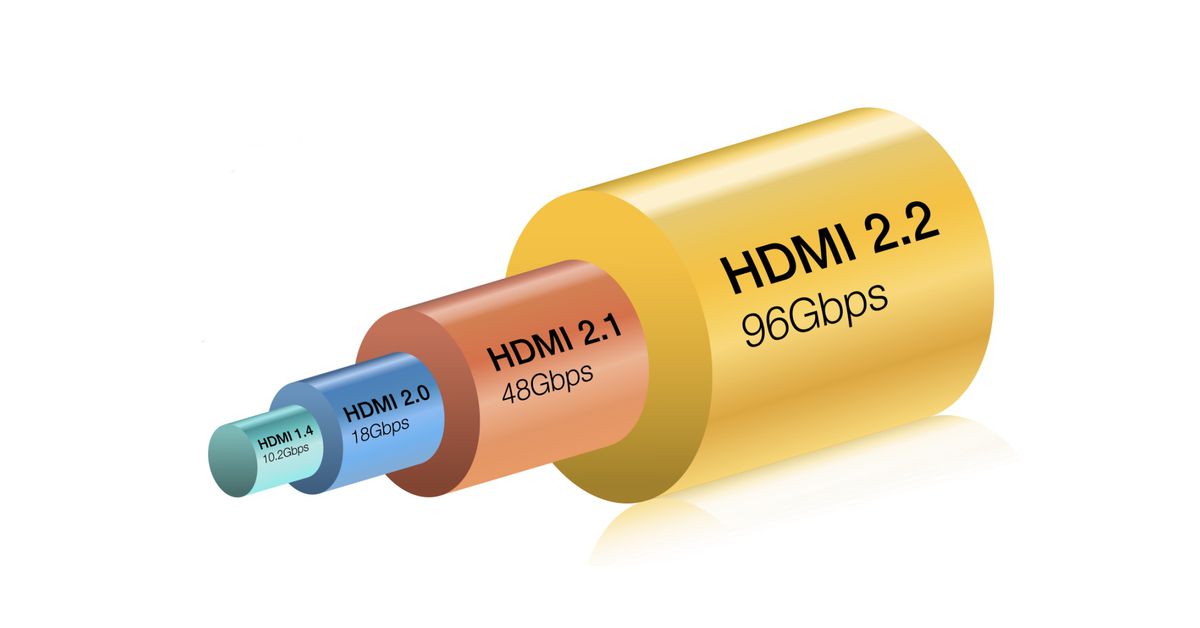- cross-posted to:
- [email protected]
- cross-posted to:
- [email protected]
The HDMI Forum is using CES — the annual showcase of all things home theater — to announce the new HDMI 2.2 specification. In a press release this morning, the trade association confirmed that the new spec will up total bandwidth significantly to a new high of 96Gbps. And yes, that means the introduction of an “Ultra96” HDMI cable that “enables all the HDMI 2.2 specification features.”
“Higher resolutions and refresh rates will be supported and more high-quality options will be provided,” the HDMI Forum said in its release. An example of an HDMI 2.2 cable (below) calls out some of those, including 4K at up to 480Hz, 8K at up to 240Hz, and 10K at 120Hz. Current HDMI cables can already pass 4K at 120Hz, so I doubt most people will feel any temptation to upgrade for years to come. And you’ll need content for any of these higher resolutions to be worthwhile, and there’s still a dearth of native 8K entertainment out there.
But with many TVs now offering 4K at up to 144Hz, and as consumers gravitate towards larger screens, the HDMI Forum sees ample reason to keep pushing forward.
There is at least a more helpful aspect of this spec for everyone: HDMI 2.2 includes a “Latency Indication Protocol (LIP) for improving audio and video synchronization, especially for multiple-hop system configurations such as those with an audio video receiver or soundbar.” In my experience, HDMI 2.1 and eARC have mostly resolved frustrating audio / video sync issues, but they can still pop up as a frustration depending on your setup. Apparently HDMI 2.2 will go further in keeping everything lined up and keeping this headache in the past.
Interestingly, the HDMI Forum is already anticipating tariff issues and has implemented an extensive certification program that includes anti-counterfeit labeling on packaging. You certainly can’t miss the Ultra96 badging.
HDMI 2.2 will be released in the first half of this year and be widely available “to all HDMI 2.x adopters.” Your TV and external devices will need to support the specification in order to unlock that new level of bandwidth, so we’re just starting down what’s inevitably going to be a long road.



Can someone force cable manufacturers to print the bandwidth or at least the version on the fucking cable already?!
Half of them will print the highest bandwidth regardless of the actual cable’s capabilities so that won’t help.
The options are to hope the writing is accurate, or to change the connector to break cross-compatibility.
Buy cables from reputable sources and return anything that doesn’t do what it’s advertised to do, I guess. I like having as few ports as possible! Haha
Nothing stops them from putting the “new” connector on a shitty cable either.
One way to do this is trademark law. You have a trademarked logo that says you can only use it if your cable meets certain standards. You can get sued if you label a cable that doesn’t meet it.
SD cards and USB work this way. This relies on the trademark holder enforcing it, which doesn’t always happen.
I mean, sure, but we’re assuming they’d have to be truthful.
Bold assumption…
It is, but I’m just ranting about what I want so I’m allowed to ask for fairy dust and tasty sugar-free candy.
Sounds like “burdensome regulation” to me.
Communist.
/s
They do but probably not in a way that you understand. Instead of the bandwidth which to be honest most people won’t know what that means either, they use
STANDARD HDMI CABLE
STANDARD HDMI CABLE WITH ETHERNEiT
HIGH SPEED HDMI CABLE
HIGH SPEED HDMI CABLE WITH ETHERNET
ULTRA HIGH SPEED HDMI CABLE
Each one specifies the standard and is almost always printed on the cable. I can’t think of any off the top of my head that wasn’t labeled but I’m sure there are and if you don’t see it printed on the cable then throw it out.
You can read more about this naming convention here. https://www.cablematters.com/Blog/HDMI/HDMI-cable-types-the-ultimate-guide
High Speed is the second slowest cable and the slowest one still being sold. Last time I bought an HDMI cable, I didn’t even know there was anything slower than 1080p@60hz so I just assumed that was “Standard” and, by buying “High Speed”, I was getting something better. Yes, I should have done more research before buying but the point is that calling the slowest cable still being sold “High Speed” is confusing and deceptive. That’s why I want them to be forced to label the cables with the bandwidth or version.
Why do that when you can just make the same cable you’ve been selling all along and change the description to “Full HD 1080p 4K 8K 16K 48GBPS 96GPS PlayStation 4 5 6 Switch 2 Xbox Series X S One 360 Male Female HDMI 1.1 1.2 1.3 2.0 2.1 2.2 Cable” on Amazon.
Yeah, that’s why I said somebody needs to force them. Like how food can’t say chocolate if it doesn’t actually have chocolate.